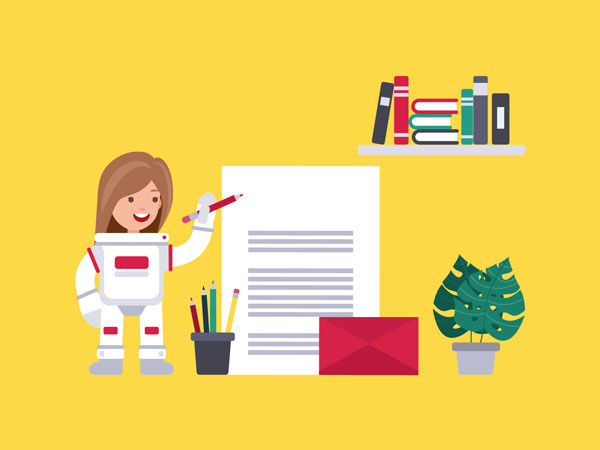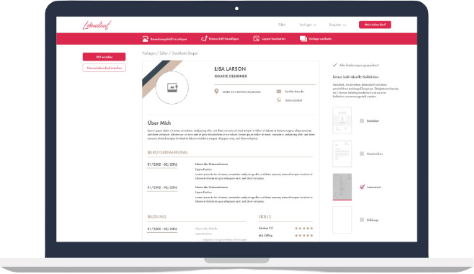
Alongside your CV, the cover letter is the most important document in your job application. It gives you the opportunity to introduce yourself in more detail, highlight your strengths, and provide examples to support them.
Each cover letter should be tailored to the position in question. The correct job application letter format is important to help recruiters know where to find what information.
In this guide, we will show you how to structure your cover letter and what to look out for in terms of visual design.
Before we get into the details of the job application letter format, you should know how a German job application is structured. Although the CV is the centrepiece of your application, the cover letter is always the first document.
If you are applying by email, you can write the cover letter in the email itself or send your full application as an attachment. We usually recommend the second option as you can be sure that all of your documents are complete. In the email itself, you can include a short text referring to the attached documents.
If you are sending a printed application portfolio, the cover letter should always be on top of the documents - even if you are adding a cover page.
The cover letter is basically a business letter. There is a German standard for business letters that you can use as a guide for your job application letter format: the DIN 5008. In some industries it may be mandatory to write a letter according to DIN 5008 - but usually you don't have to stick to it so strictly.
Please note: Your cover letter should never be longer than one page.
You start your cover letter with a classic letterhead that includes your personal details, and those of the recipient. Your name, address, telephone number, and email address should be on the right-hand side.
Alternatively, you can include this information in a header. The advantage of this is that your personal details will appear on every page of your job application. It is also a space-saving method.
This is followed by the recipient's details, left-aligned. Remember to include the recipient's full name, correct company name, and address. You only need to include the country if you are applying abroad. The last part of the header is the current date, again right-aligned. You can also include the place where you wrote the job application.
Max Mustermann
Hauptstraße 11
10411 Berlin
Telefon: 0176/123456789
E-Mail: firtname@lastname.de
The Company GmbH
Attn. Human Resources Department
Gewerbestraße 11
D-10166 Berlin
01.01.2024
The subject line should ideally be one line, but no more than two. You do not need to start this line with the word "Subject:", but you can emphasise it by writing it in bold.
The main body of the cover letter is where you introduce yourself and highlight your strengths. As this guide is about the job application letter format, we will only briefly outline the most important points.
The cover letter is divided into three sections: introduction, body, and conclusion. You should devote a separate paragraph to each section, although the main body should be divided into further paragraphs.
At the end of your cover letter, you can use the simple word "attachments" to indicate that there are certificates and other supporting documents. You may also list them in bullet points if you have enough space.
In addition to the correct job application letter format, which makes your cover letter easier to read, an appealing visual design is also important. Again, there are a number of details to consider.
Your CV and cover letter should be as consistent as possible. Choose a font that you will use throughout your job application. Make sure that it is easy to read.
You can choose between serif and sans serif fonts. Sans-serif fonts, such as Arial, are well suited for reading on screen - serif fonts, such as Times New Roman, are easier to read on paper.
Another important consideration is the size of the font: ideally, it should be between 10 and 12 points.
You have two options when it comes to the text alignment in the job application letter format: you can align the text to the left or centre it. If you choose to centre your text, make sure it is evenly spaced - if it is too wide, you may end up with large gaps, which you should avoid. You can't go wrong with left-aligned text.
Choose a suitable line spacing for the job application letter format. It should be easy to read and still fit on one page. Single-spaced text is usually the best solution.
When it comes to margins in the job application letter format, most applicants simply rely on the margins already set in their word processing software - in most cases this is perfectly adequate.
Some applicants try to create more space for their text by making the margins particularly narrow. Not only is this very noticeable, but it also makes the cover letter look too wide. Instead, try to concentrate on the most important information in your text.
Less is more - stick to this adage when it comes to visually enhancing your cover letter. Choose one or at most two accent colours. For fonts, stick to classic black, as legibility is always a top priority.
You should also use patterns sparingly in the background, header, or footer of your cover letter - after all, the design must not distract from the content.
If you don't feel confident enough to design your own job application letter format, it's a good idea to use a ready-made template.
On our website you will find a wide range of cover letter templates, from the classic to the creative. You can customise them with just a few clicks in our CV editor.
 Start CV editor
Start CV editor
You should always make sure that you write your own text and personalise your cover letter. If you accidentally use a placeholder or mention skills that don't apply to the job, you won't make a good impression.
If you found this article interesting, you may also be interested in the following articles: